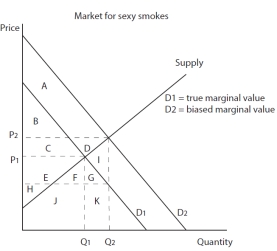Deck 4: Efficiency and Imperfect Markets
Question
Question
Question
Question
Question
Question
Question
Question
Question
Question
Question

Unlock Deck
Sign up to unlock the cards in this deck!
Unlock Deck
Unlock Deck
1/11
Play
Full screen (f)
Deck 4: Efficiency and Imperfect Markets
1
The fundamental rule of policy analysis is
A)adopt a policy if more people benefit from it than don't
B)adopt a policy only if there are no costs
C)adopt a policy if total benefits are greater than total costs
D)adopt a policy if there are any total benefits
A)adopt a policy if more people benefit from it than don't
B)adopt a policy only if there are no costs
C)adopt a policy if total benefits are greater than total costs
D)adopt a policy if there are any total benefits
C
2
Kaldor-Hicks principle states that a policy should be adopted
A)if net benefits are positive and the winners compensate the losers
B)if there are more winners than losers
C)if there are no losers
D)if the winners could in principle compensate the losers
A)if net benefits are positive and the winners compensate the losers
B)if there are more winners than losers
C)if there are no losers
D)if the winners could in principle compensate the losers
D
3
For a monopoly
A)market demand=firm demand
B)the firm's demand is horizontal
C)the firm's demand=market supply
D)the firm's demand is vertical
A)market demand=firm demand
B)the firm's demand is horizontal
C)the firm's demand=market supply
D)the firm's demand is vertical
A
4

Figure 4-10 shows a market where consumers have imperfect information.D1 shows the true marginal value and D2 shows biased marginal value.Which is the deadweight loss due to imperfect information?
A)D
B)F+G
C)C+E
D)I

Unlock Deck
Unlock for access to all 11 flashcards in this deck.
Unlock Deck
k this deck
5

In Figure 4-11 the consumer surplus with biased information is
A)A+B
B)B
C)B+C
D)B-D-I

Unlock Deck
Unlock for access to all 11 flashcards in this deck.
Unlock Deck
k this deck
6
Use the following equations for the following two questions
Demand: P=120-Q
Marginal private cost: P=30+1/2Q
Marginal social cost: MCS=30+Q
What is the private equilibrium quantity and price?
A)Q=60, P=60
B)Q=45, P=75
C)Q=12, P=108
D)Q=75, P=45
Demand: P=120-Q
Marginal private cost: P=30+1/2Q
Marginal social cost: MCS=30+Q
What is the private equilibrium quantity and price?
A)Q=60, P=60
B)Q=45, P=75
C)Q=12, P=108
D)Q=75, P=45

Unlock Deck
Unlock for access to all 11 flashcards in this deck.
Unlock Deck
k this deck
7
Use the following equations for the following two questions
Demand: P=120-Q
Marginal private cost: P=30+1/2Q
Marginal social cost: MCS=30+Q
What is the social equilibrium quantity and price?
A)Q=45, P=75
B)Q=60, P=60
C)Q=12, P=108
D)Q=75, P=45
Demand: P=120-Q
Marginal private cost: P=30+1/2Q
Marginal social cost: MCS=30+Q
What is the social equilibrium quantity and price?
A)Q=45, P=75
B)Q=60, P=60
C)Q=12, P=108
D)Q=75, P=45

Unlock Deck
Unlock for access to all 11 flashcards in this deck.
Unlock Deck
k this deck
8

In Figure 4-11, the consumer surplus with perfect information would be
A)A+B
B)B
C)B+C
D)B-D-I

Unlock Deck
Unlock for access to all 11 flashcards in this deck.
Unlock Deck
k this deck
9
An externality is
A)a cost to a party not involved in the production or consumption of a good
B)a cost to a party involved in the production or consumption of a good
C)a benefit to a party not involved in the production or consumption of a good
D)both a and c
A)a cost to a party not involved in the production or consumption of a good
B)a cost to a party involved in the production or consumption of a good
C)a benefit to a party not involved in the production or consumption of a good
D)both a and c

Unlock Deck
Unlock for access to all 11 flashcards in this deck.
Unlock Deck
k this deck
10
The profit maximizing quantity for a monopoly is where
A)marginal revenue is 0
B)marginal revenue=marginal cost
C)marginal cost=demand
D)consumer surplus is minimized
A)marginal revenue is 0
B)marginal revenue=marginal cost
C)marginal cost=demand
D)consumer surplus is minimized

Unlock Deck
Unlock for access to all 11 flashcards in this deck.
Unlock Deck
k this deck
11
Pareto optimality is a situation where
A)it is possible to make any person better off without making at least one person worse off
B)every individual has reached their maximum utility
C)each individual can make the optimal choice to maximize their utility
D)every individual remains at their endowment point.
E)any improvement in one person's utility must lead to a reduction in another person's utility.
A)it is possible to make any person better off without making at least one person worse off
B)every individual has reached their maximum utility
C)each individual can make the optimal choice to maximize their utility
D)every individual remains at their endowment point.
E)any improvement in one person's utility must lead to a reduction in another person's utility.

Unlock Deck
Unlock for access to all 11 flashcards in this deck.
Unlock Deck
k this deck



